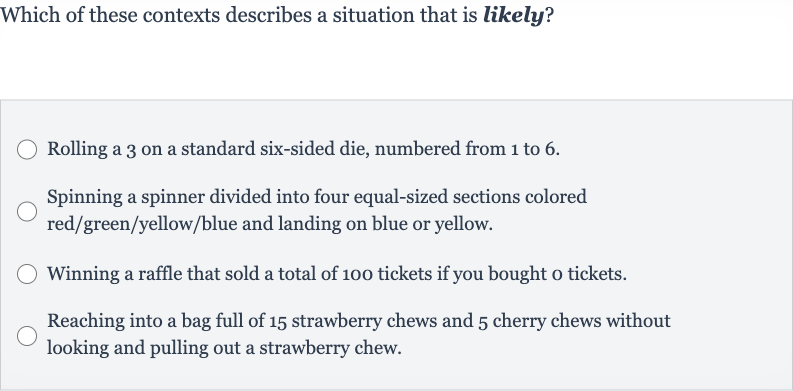AI tutor
Welcome to Bytelearn!
Let’s check out your problem:

Which of these contexts describes a situation that is likely?Rolling a on a standard six-sided die, numbered from to .Spinning a spinner divided into four equal-sized sections colored red/green/yellow/blue and landing on blue or yellow.Winning a raffle that sold a total of tickets if you bought o tickets.Reaching into a bag full of strawberry chews and cherry chews without looking and pulling out a strawberry chew.
Full solution
Q. Which of these contexts describes a situation that is likely?Rolling a on a standard six-sided die, numbered from to .Spinning a spinner divided into four equal-sized sections colored red/green/yellow/blue and landing on blue or yellow.Winning a raffle that sold a total of tickets if you bought o tickets.Reaching into a bag full of strawberry chews and cherry chews without looking and pulling out a strawberry chew.
- Rolling a Probability: Analyze the likelihood of rolling a on a standard six-sided die. A standard six-sided die has six equally likely outcomes when rolled. The probability of rolling a is the chance of one specific outcome occurring. Probability of rolling a =
- Spinner Color Probability: Analyze the likelihood of spinning a spinner divided into four equal-sized sections and landing on blue or yellow.The spinner has four equal sections, so the probability of landing on any one color is . Since there are two favorable outcomes (blue or yellow), we add the probabilities of each.Probability of landing on blue or yellow =
- Raffle Ticket Probability: Analyze the likelihood of winning a raffle with tickets sold if you bought tickets.If you have not bought any tickets, you have no chance of winning. The probability is zero.Probability of winning with tickets =
- Chew Selection Probability: Analyze the likelihood of reaching into a bag with strawberry chews and cherry chews and pulling out a strawberry chew.There are a total of chews in the bag, and of them are strawberry. The probability of pulling out a strawberry chew is the number of strawberry chews divided by the total number of chews.Probability of pulling out a strawberry chew
- Likely Situations: Determine which situation is likely based on the probabilities calculated.Rolling a on a die (), spinning blue or yellow (), winning a raffle with tickets (), and pulling out a strawberry chew () are the probabilities we have calculated. The likely situations are those with a probability greater than zero.Rolling a on a die is likely, spinning blue or yellow is likely, winning a raffle with tickets is not likely, and pulling out a strawberry chew is likely.
More problems from Interpret confidence intervals for population means
QuestionGet tutor help
QuestionGet tutor help
QuestionGet tutor help
QuestionGet tutor help
QuestionGet tutor help
QuestionGet tutor help
QuestionGet tutor help
